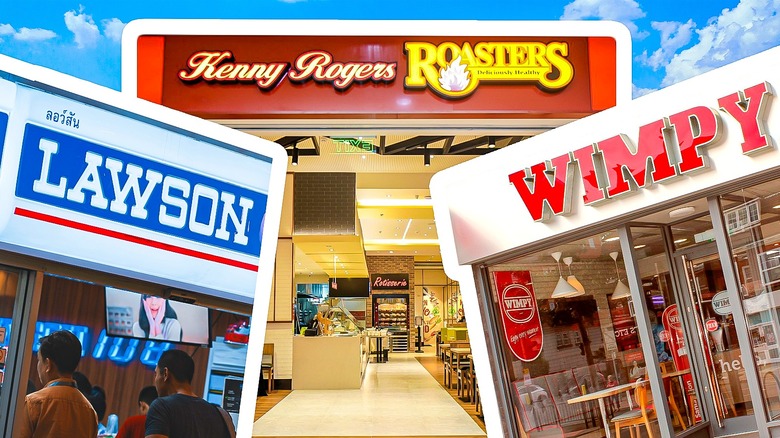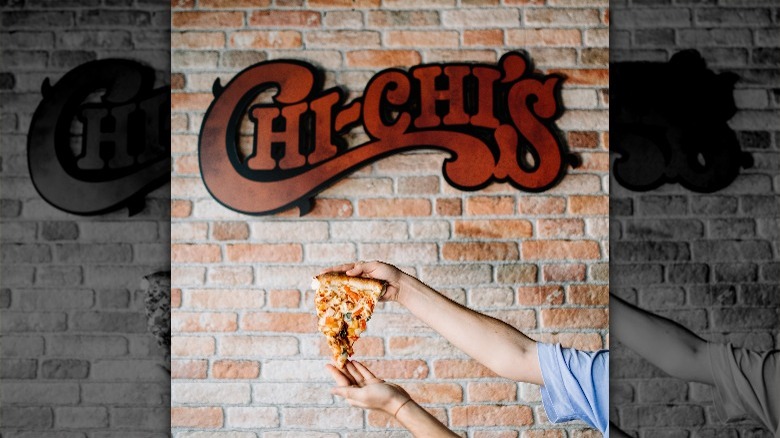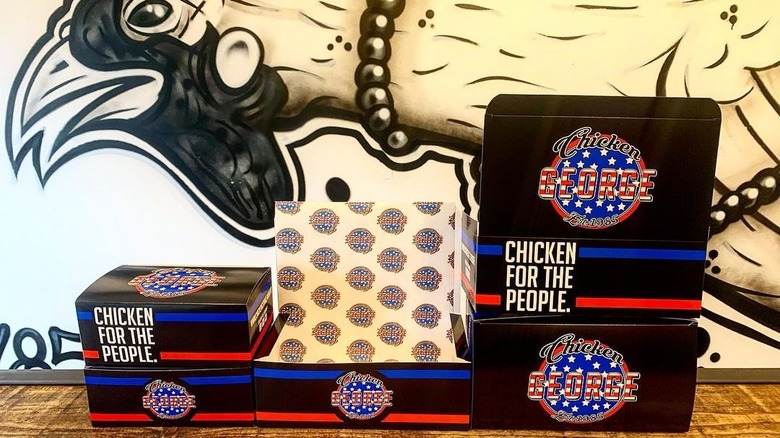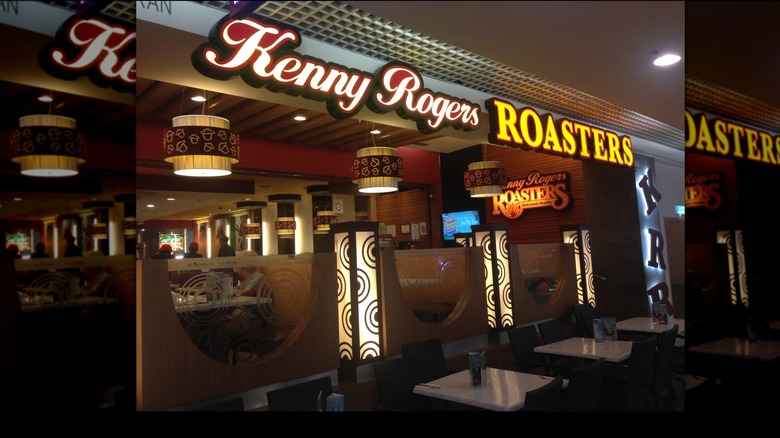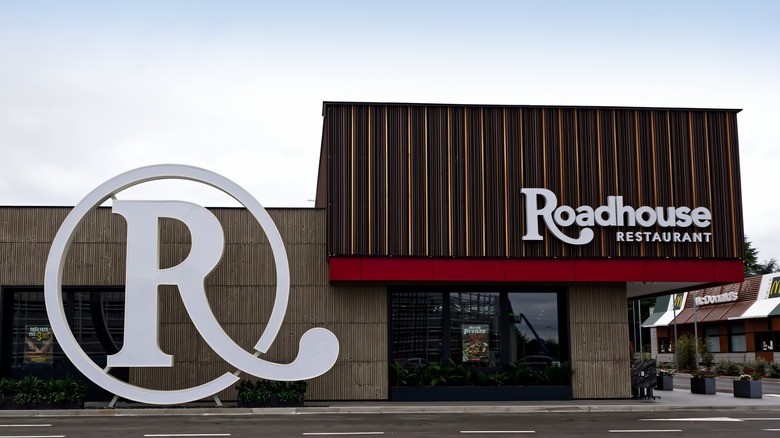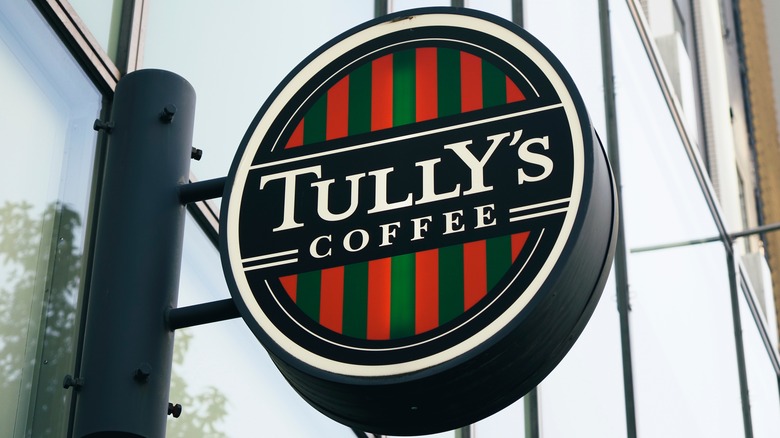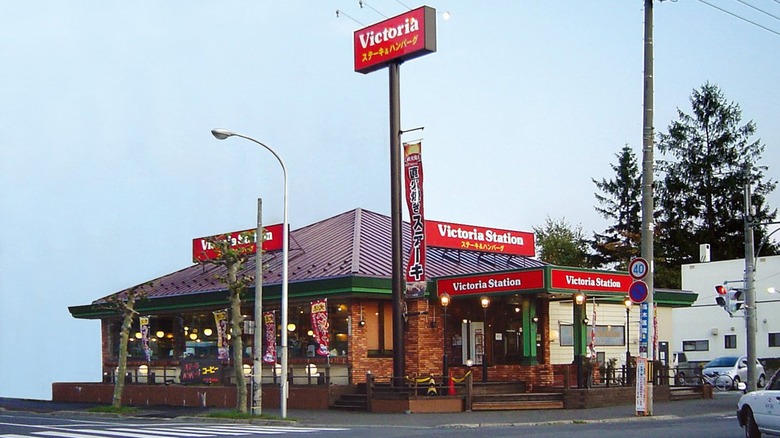8 Defunct American Chains That Still Exist In Other Countries
America's true beauty lies in the fact that it is a large melting pot where ethnicities and cultures the world round come together to live in an imperfect harmony. Cuisines once foreign and even unforgiving to the shores of the United States have been adapted to suit a more continental palette, and in return, spreading to the globe new definitions of what exactly "Chinese," "Italian," "Greek," and other foods are.
Chain restaurants, fast food joints, and even convenience stores are one of the great exporters of food cultures from America to other countries who want the taste without leaving their home country; or perhaps for Americans traveling abroad who want a taste of home. What's even more amazing is that in some rare cases, some of these chains have gone out of business in the US, and yet continue to thrive outside of its borders, keeping the name, image, and most importantly, the food and drinks to live another day. Let's crack open the history books and see what sank these chains back home, and then whip out an atlas and see where these defunct American chains still exist in other countries.
1. Chi-Chi's
After finding success with the Mexican chain Zapata's, in 1975, Minnesotan Marno McDemott embarked on another south-of-the-border venture with partner, and Green Bay Packers legend, Max McGee called Chi-Chi's. Marno told The Minneapolis Star the name was Spanish for "big boobs," and was also the nickname for his wife. It soon became a chain as large as its chimichangas with 200 locations in the United States and Canada in place by 1988.
That same year, Chi-Chi's crossed the Atlantic and set up outposts in Belgium, Germany, Luxembourg, and even Kuwait. Former Vice President Terry Smith, told the Los Angeles Times, "Somehow, somewhere, in every country we're always able to find some Mexicans who are ready and willing to strike up the band." Expansion would later include The United Kingdom, The Netherlands, China, and Indonesia.
Back home, after changing owners several times, selling off the brand name and recipes to Hormel, and eventually declaring bankruptcy in 2003, a disturbing reason shut down Chi-Chi's in America — an outbreak of hepatitis A that resulted in 650 people being sick and four deaths.
Outback Steakhouse scooped up 76 Chi-Chi's locations and converted them into their own restaurants. On the Chi-Chi's website, it wrote "We would like to thank all of our loyal customers of the past 27 years and with a tear in our eye, say Adios" (via AP). Today, all that remains is a single location in Vienna, Austria, where burritos share menu space with pizza, ribs, and burgers.
2. Chicken George
After interviewing 14,000 people, testing 300 recipes, and frying more than 17,000 pieces of chicken, Ted Holmes found the potential keys to fast food success with his Baltimore-based Chicken George restaurant in 1979. Named after the untrademarked character Chicken George in Alex Haley's "Roots," Holmes' fried chicken chain had quite the legs. Within four years, it had the highest average sales per unit for a fast food restaurant chain, which prompted the likes of Kentucky Fried Chicken and McDonald's to send in spies to see what the secret was.
By 1986, after a lack of marketing and advertising, and having financial trouble, the company filed for bankruptcy. While there were two rounds of new ownership, neither was able to make it work and the company flew the coop for good in 1991.
While the American Chicken George franchise was running afoul in the mid-1980s, British restaurants of the same name, (but of no apparent direct relation) took flight. Ray Cheah worked for KFC but decided to open his own finger-licking good fried chicken joint in Luton, in 1985. Today, his son Chris Cheah has kept the brand name going, as an award-winning wing spot called Chicken George Jnr. Additionally, based on an advertisement in the Kent and Sussex Courier from 1987, there was a separate British Chicken George chain that had 11 branches, including one in West Germany.
3. Kenny Rogers Roasters
While Colonel Sanders was the face of Kentucky Fried Chicken, it was John Y. Brown who turned the franchise into a global empire. After a long stint as Governor of Kentucky (naturally), Brown teamed up with another beloved face for a new chicken venture with a spin — rotisserie. In 1991, he and the country music legend launched Kenny Rogers Roasters. Within three years they had 167 locations within 31 states, and in 1996 achieved television comedy immortality (and got free advertising) by being the focus of a memorable "Seinfeld" episode. Rogers laughingly told the AP, "I'm making more money out of the chicken thing than I ever made on my music."
Brown walked away from the business in 1996, and when the company filed for bankruptcy two years later, Rogers wanted to fold 'em and walk away too. Kenny Rogers Roasters hung on a bit longer in the states, with the final location in Ontario, California, closing its doors in 2011.
America's loss was Asia's gain, as the Malaysian-based Berjaya Corporation Berhad became involved with the brand and franchised it in 1994; by 2008, it owned the entire rights to the chain. At one point, the Berjaya Group opened locations in China, Bangladesh, and Cambodia. While Kenny Roger passed away in 2020, his name continues to rock on in Singapore, Brunei, Malaysia, and numerous locations in The Philippines.
4. Lawson
In the 1930s, Ohioan James J. Lawson upended the entire milk industry by offering refrigerated milk by the gallon at an incredibly low price point. Instead of delivering the milk, he opened retail stores to sell them. The Lawson Milk Co. grew into a beloved set of convenience stores and numbered 173 by the time the company was acquired by Consolidated Foods in 1958. Consolidated Foods expanded Lawson's reach to five Midwestern states, with over 740 stores by the 1970s.
In 1975, the Japanese company Daiei entered into a partnership with Consolidated Foods, and that same year opened the first Lawson (no "s") store in Sakurazuka, Japan. At first, the offerings were a carry-over of the American brand, but eventually were adapted to Japanese tastes. The chain has since grown to more than 14,000 locations in its new home: 4,000 in China, and others in Indonesia, Thailand, and The Philippines.
In 1985, the American Lawson's was bought by Dairy Mart Convenience Stores; two years later it renamed all the Lawson's to match its own brand name. After going bankrupt in 2002, the Canadian company Alimentation Couche-Tard acquired it and converted it to Circle K, where some locations continued to carry the locally-loved Lawson's Chip Dip. In an interesting twist, it was the Japanese company that gave Lawson's a second lease on life back in America, as two outposts opened in Hawaii in 2012. Upon the news, J.J. Lawson's son Norman "Red" told the Akron Beacon Journal, "It's nice to see our name spread all around."
5. Roadhouse Grill
Moderately priced steaks, free peanuts, and boozy drinks in mason jars were the foreground fare enjoyed in the country-and-western-vibed background that Roadhouse Grill provided. The chain was founded by David Toole in 1992 in Pembroke Pines, Florida. KFC and Kenny Rogers Roasters franchise mastermind John Y. Brown came on board shortly thereafter to work his magic on Roadhouse Grill and at the chain's peak, operated at 85 locations.
Roadhouse Grill made the leap to Maylasia, as well as locations in Kuala Lumpur and Brazil. In 2000, the American company struck a deal with the Italian meat packing firm Cremonini SpA to branch out into Europe, with president and chief executive officer Ayman Sabi telling The Sheboygan Press, "We look forward to the added brand awareness that this will bring us."
The American Roadhouse Steakhouse chain declared bankruptcy twice and shut down for good in the states in 2008. The Italian version, now known as Roadhouse Restaurant, was the very first steakhouse chain in the country, and yes, complimentary peanuts still await guests at their tables, as do nachos. Amazingly enough, the Italian chain has far surpassed the original's holdings, as it opened its 172nd location in 2023.
With the rights to the brand in 52 European companies, Roadhouse shows no signs of slowing down. Reflecting on the past 20 years, managing director Nicolas Bigard told Food Service, "The strengths, which have ensured the success of Roadhouse, can be summed up in the quality of the product and service, in the constant effort to innovate, even digitally, and in the best possible offer at the best price."
6. Tully's Coffee
When Starbucks was looking to lease space in a shopping center run by developer Thomas O'Keefe, he had an even better idea — start his own Seattle-based coffee company. In 1992, borrowing his self-made up nickname from college, O'Keefe opened Tully's Coffee, aiming to be a friendlier, family-oriented alternative to Starbucks. By 2010, Tully's Coffee had 185 locations in America, but with constant issues turning a profit, the brand was sold to Green Mountain Coffee Roasters.
Tully's Coffee found a fan in entrepreneur Kota Matsuda, who introduced Japan to the company's brews by opening a location in Ginza in 1997. O'Keefe told the Seattle Times that the move would "act as a huge billboard for us in the balance of Asia." Today, Tully's Coffee has more than 750 locations in Japan.
In 2013, actor Patrick Dempsey, lawyer Michael Avenatti, and their Global Baristas group outbid Starbucks to obtain the bankrupt Tully's Coffee and its 40 remaining locations. After quickly falling out with Dempsey, Avennati would next butt heads with Tully's Coffee brand owner Keurig Green Mountain (who today, still sell the brand in K-Cups and bags). After years of unpaid licensing fees, the company prevented Avenatti from using the brand name, which forced the chain's percolators to turn off for good in the states in 2018.
7. Victoria Station
Cornell University grads Richard Bradley, Robert A. Freeman, and Peter Lee were such fans of the look and feel of the local watering hole and restaurant The Boxcar that they laid down their own tracks to create a railroad-themed prime rib restaurant called Victoria Station. The inaugural location opened in San Francisco in 1969, decked out with authentic British train paraphernalia, including a clock from London's actual Victoria Station and baggage carts doubling as a salad bar. The gimmick caught on, and Victoria Station ended up pulling into over 100 cities across America.
In 1979, Victoria Station opened in Japan, and under the ownership of Zensho Holdings, the chain has been chugging along on the island of Hokkaido (with far less of a train motif), although with a dwindling number of locations (28 in 2023). Operated by Zensho subsidiary Big Boy Japan since 2000, Victoria Station essentially has the same menu as Big Boy, but with an emphasis on steak.
With changing dietary habits and higher beef prices in the 80s, the American chain started to shed customers, closed down locations, and became a steakhouse that time forgot. The very last Victoria Station standing in the US was in Salem, Massachusetts, but went off the rails for good in 2017 after unpaid rent. One customer bemoaned to The Salem News, "Oh my God, what am I going to do about my root beer steak tips?"
8. Wimpy
Edward V. Gold copped the name of Popeye the Sailor Man's buddy to open a restaurant called Wimpy Grills that sold the very food the toon loved — hamburgers. What started in 1934 as a singular spot in Bloomington, Indiana, gravitated north to become a 25-store burger chain in the Chicago area over the next two decades.
When Gold decided to expand overseas by 1953, he told The Chicago Tribune, "There are so many American travelers abroad that the demand for our product and type of restaurant has forced us to look into many interesting ideas that have been suggested to us." Six years later, Wimpy (minus the "Grills") was in seven countries, and even Queen Elizabeth served the chain's fare to guests at a Buckingham Palace garden party.
By the end of the 1970s, Wimpy was in 39 countries with over 1,500 restaurants. Today, South Africa hosts the most locations with over 450, followed by the United Kingdom with over 60; there are also several in the Middle East.
The original American Wimpy chain wimped out not long after Gold's death in 1977. The US rights to the name and trademark went up for sale the following year – the same year a new unrelated chain of Wimpy's Hamburgers began life in California's San Joaquin Valley. There is also an unrelated Wimpy's within Toon Lagoon in Universal Orlando's Islands of Adventure.
